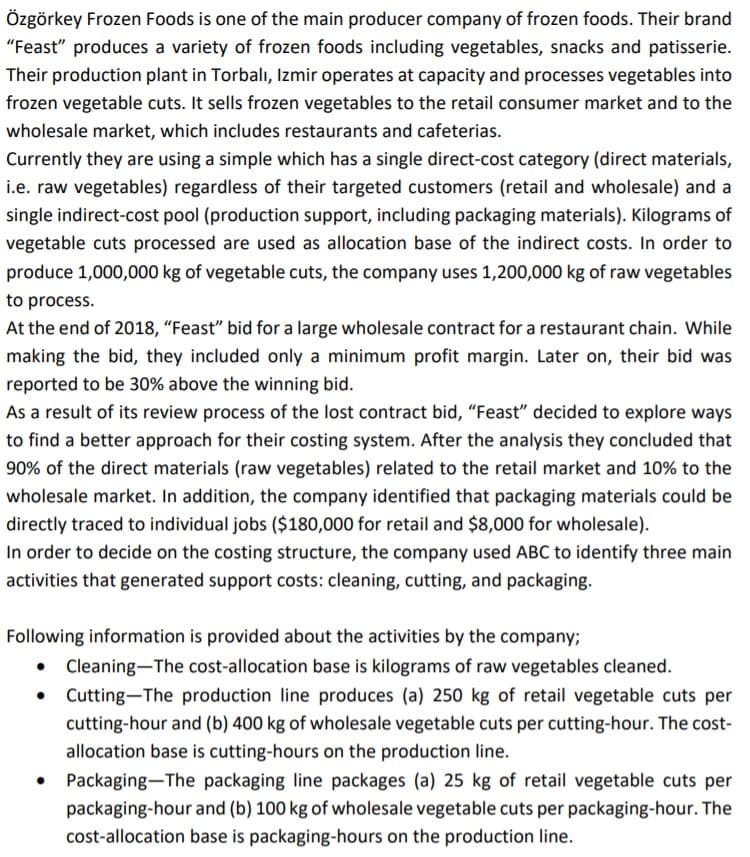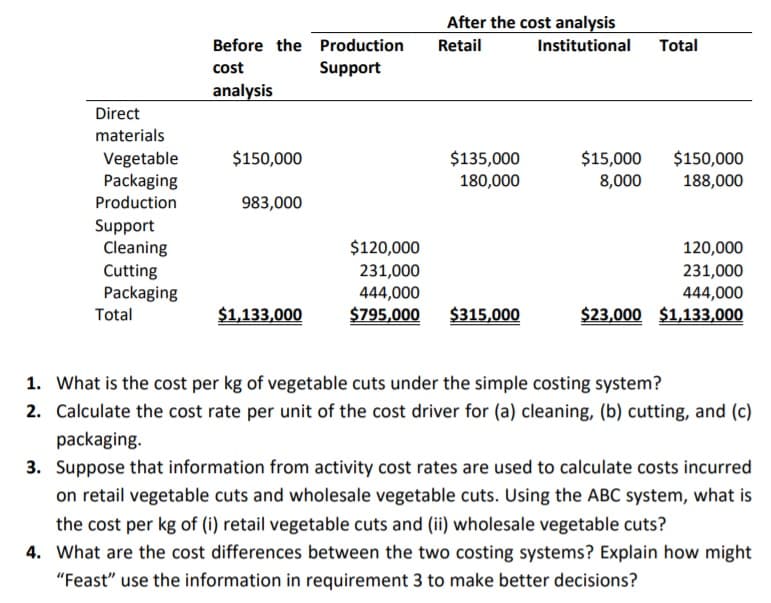n Torbalı, Izmir operate sells frozen vegetable n includes restaurants
Cornerstones of Cost Management (Cornerstones Series)
4th Edition
ISBN:9781305970663
Author:Don R. Hansen, Maryanne M. Mowen
Publisher:Don R. Hansen, Maryanne M. Mowen
Chapter17: Activity Resource Usage Model And Tactical Decision Making
Section: Chapter Questions
Problem 13E: Carleigh, Inc., is a pork processor. Its plants, located in the Midwest, produce several products...
Related questions
Question
100%

Transcribed Image Text:Özgörkey Frozen Foods is one of the main producer company of frozen foods. Their brand
"Feast" produces a variety of frozen foods including vegetables, snacks and patisserie.
Their production plant in Torbalı, Izmir operates at capacity and processes vegetables into
frozen vegetable cuts. It sells frozen vegetables to the retail consumer market and to the
wholesale market, which includes restaurants and cafeterias.
Currently they are using a simple which has a single direct-cost category (direct materials,
i.e. raw vegetables) regardless of their targeted customers (retail and wholesale) and a
single indirect-cost pool (production support, including packaging materials). Kilograms of
vegetable cuts processed are used as allocation base of the indirect costs. In order to
produce 1,000,000 kg of vegetable cuts, the company uses 1,200,000 kg of raw vegetables
to process.
At the end of 2018, "Feast" bid for a large wholesale contract for a restaurant chain. While
making the bid, they included only a minimum profit margin. Later on, their bid was
reported to be 30% above the winning bid.
As a result of its review process of the lost contract bid, “Feast" decided to explore ways
to find a better approach for their costing system. After the analysis they concluded that
90% of the direct materials (raw vegetables) related to the retail market and 10% to the
wholesale market. In addition, the company identified that packaging materials could be
directly traced to individual jobs ($180,000 for retail and $8,000 for wholesale).
In order to decide on the costing structure, the company used ABC to identify three main
activities that generated support costs: cleaning, cutting, and packaging.
Following information is provided about the activities by the company;
Cleaning-The cost-allocation base is kilograms of raw vegetables cleaned.
Cutting-The production line produces (a) 250 kg of retail vegetable cuts per
cutting-hour and (b) 400 kg of wholesale vegetable cuts per cutting-hour. The cost-
allocation base is cutting-hours on the production line.
Packaging-The packaging line packages (a) 25 kg of retail vegetable cuts per
packaging-hour and (b) 100 kg of wholesale vegetable cuts per packaging-hour. The
cost-allocation base is packaging-hours on the production line.

Transcribed Image Text:After the cost analysis
Before the Production
Retail
Institutional
Total
cost
Support
analysis
Direct
materials
Vegetable
Packaging
$150,000
$15,000
$150,000
$135,000
180,000
8,000
188,000
Production
983,000
Support
Cleaning
$120,000
120,000
231,000
Cutting
Packaging
231,000
444,000
444,000
Total
$1,133,000
$795,000
$315,000
$23,000 $1,133,000
1. What is the cost per kg of vegetable cuts under the simple costing system?
2. Calculate the cost rate per unit of the cost driver for (a) cleaning, (b) cutting, and (c)
packaging.
3. Suppose that information from activity cost rates are used to calculate costs incurred
on retail vegetable cuts and wholesale vegetable cuts. Using the ABC system, what is
the cost per kg of (i) retail vegetable cuts and (ii) wholesale vegetable cuts?
4. What are the cost differences between the two costing systems? Explain how might
"Feast" use the information in requirement 3 to make better decisions?
Expert Solution
This question has been solved!
Explore an expertly crafted, step-by-step solution for a thorough understanding of key concepts.
Step by step
Solved in 2 steps with 4 images

Knowledge Booster
Learn more about
Need a deep-dive on the concept behind this application? Look no further. Learn more about this topic, accounting and related others by exploring similar questions and additional content below.Recommended textbooks for you

Cornerstones of Cost Management (Cornerstones Ser…
Accounting
ISBN:
9781305970663
Author:
Don R. Hansen, Maryanne M. Mowen
Publisher:
Cengage Learning

Essentials of Business Analytics (MindTap Course …
Statistics
ISBN:
9781305627734
Author:
Jeffrey D. Camm, James J. Cochran, Michael J. Fry, Jeffrey W. Ohlmann, David R. Anderson
Publisher:
Cengage Learning

Principles of Cost Accounting
Accounting
ISBN:
9781305087408
Author:
Edward J. Vanderbeck, Maria R. Mitchell
Publisher:
Cengage Learning

Cornerstones of Cost Management (Cornerstones Ser…
Accounting
ISBN:
9781305970663
Author:
Don R. Hansen, Maryanne M. Mowen
Publisher:
Cengage Learning

Essentials of Business Analytics (MindTap Course …
Statistics
ISBN:
9781305627734
Author:
Jeffrey D. Camm, James J. Cochran, Michael J. Fry, Jeffrey W. Ohlmann, David R. Anderson
Publisher:
Cengage Learning

Principles of Cost Accounting
Accounting
ISBN:
9781305087408
Author:
Edward J. Vanderbeck, Maria R. Mitchell
Publisher:
Cengage Learning